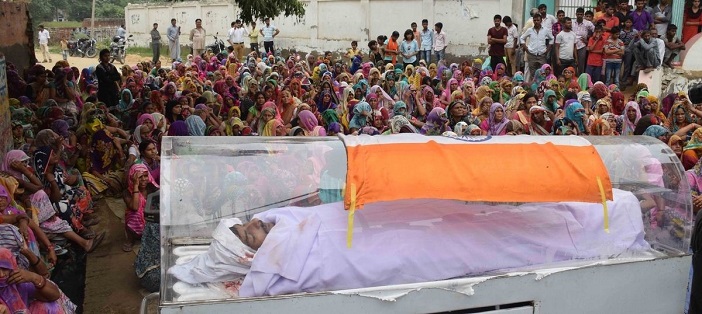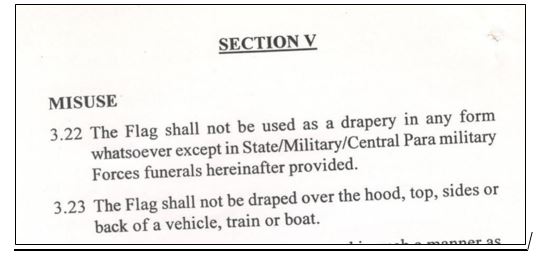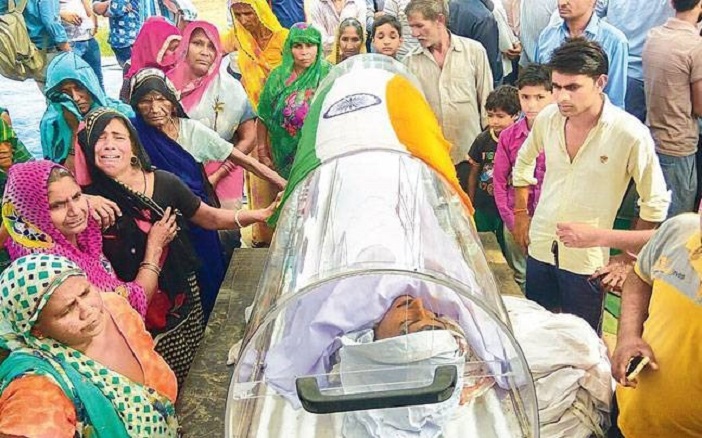[orc]Ravi Sisodia’s dead body was draped with an Indian Flag recently. As per the flag code of India, draping the flag in a civilian funeral (if it’s not a state funeral) is an offence.
Bishara, a small village in Uttar Pradesh was mourning the death of a 22-year old resident, Ravi Sisodia. Ravi along with 18 others is accused of killing Mohmmad Akhlaq, claiming that he had eaten beef in his home. He passed away at LNJP hospital in Delhi, while in judicial custody.
On October 5th 2016, day after his death, large number of villagers gathered for his funeral in Bishara. The dead body was laid in the open community space, placed in a transparent casket. There was something unusual in the pictures of this funeral, the casket was covered with the Indian national flag. The tricolor draped over a civilian’s dead body and that too of a man who has been accused of murder and was in judicial custody. So, can the flag be draped over anything or anybody?

Picture Courtesy: IANS
A local reporter also tweeted a short video of the incident.
Hum iska badla le kar rahenge.Hinduon ne chudiyan nahi pahan rakhi hain. In mullon ko jad se ukhaad phenke ge hum, says a speaker in #dadri pic.twitter.com/7D9mVMKKQh
— Mohammad Ali (@hindureporter) October 6, 2016
The Flag Code of India
Every country has a Flag Code. The flag code is a set of rules to be followed in regard to the use of the national flag in various capacities. From hoisting the national flag to draping it over a casket, it contains things to do and things that cannot be done.
According to Section V of the Flag Code of India,
“The Flag shall not be used as a drapery in any form whatsoever except in State/Military/Central Para military Forces funerals herein after provided.
The Flag shall not be used as a drapery in any form whatsoever, including private funerals;
The Flag shall not be draped over the hood, top, sides or back of a vehicle, train or boat.”

The funeral in Bishara was neither of the ones mentioned in the Flag Code. Hence it was a clear case of misuse of the flag. And if there was a misuse of the flag like in Bishara, the Flag Code of India also outlines the consequences under the law of the land. The Flag Code of India is essentially governed by two laws, the Emblems and Name (Prevention and Improper Use) Act, 1950 and Prevention of Insults to the National Honour Act 1971. Both these acts extend to the whole of India.

Picture Courtesy: Twitter
Violation & the Punishment
Draping the tricolor in a civilian funeral comes under the Prevention of Insults to the National Honour Act of 1971. The Act states,
“ Whoever in any public place or any other place within public view burns, mutilates, defaces, defiles, disfigures, destroys, tramples upon or otherwise shows disrespect or brings into contempt (either by words spoken, written or acts) the Indian National Flag or the Constitution of India or any part thereof, shall be punished with imprisonment for a term that may be extended up to three years or with fine or with both.”

Disrespect to the flag includes many clauses, out of which, using the Indian National Flag as drapery in any form whatsoever in except State/Military/Central Para military Forces funerals amounts to violation. The incident in Bishara, draping the transparent casket with the Indian National Flag is a violation that should have amounted to imprisonment and fine. But clearly, neither the villagers nor the law enforcement agencies followed the law. It will important to note that, the area around Bishara, was also under section 144 that night, indicating that there was a heavy police presence and surveillance and the visit of a Union Minister. Either nobody noticed or everybody ignored wanting to portray the death of the deceased who was accused as a pseudo- martyr and intentional disrespect.
As a little girl, when I watched a scene in the movie Roja, where the hero runs and falls on a burning national flag, I had no understanding of the sentiment of nationalism, his need to extinguish the fire or the Flag Code. Today, my idea of nationalism is still as unclear because of what we do in the name of it, but at least the Flag Code of India is an easy document for us to read and practice.


